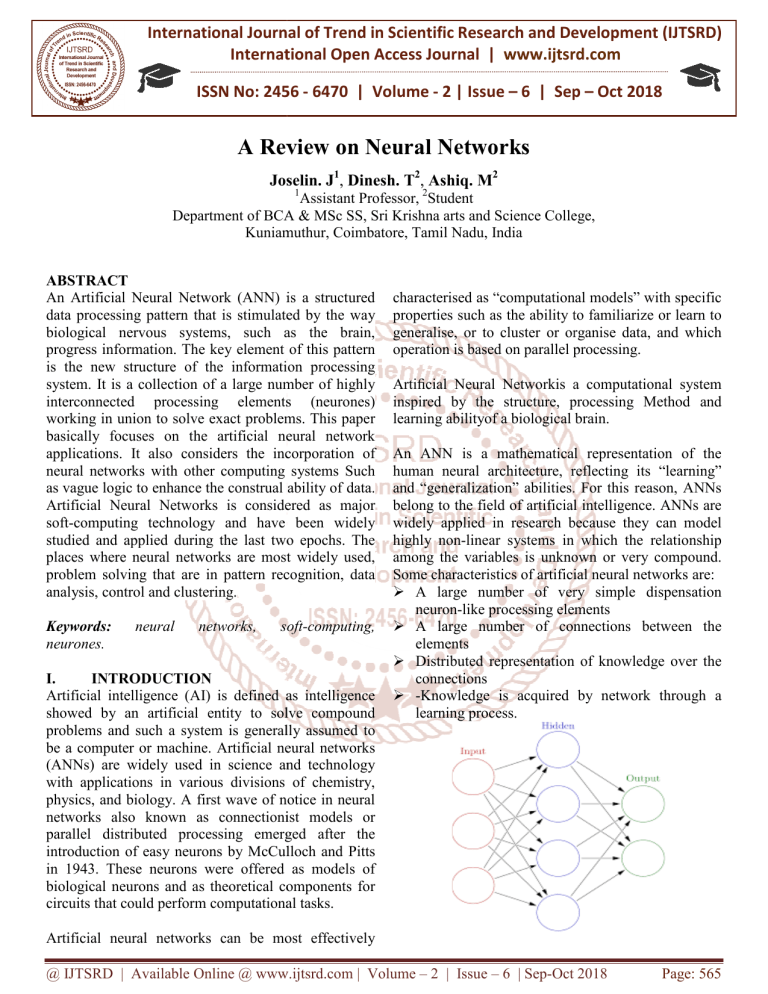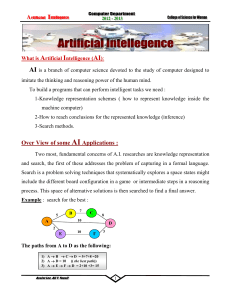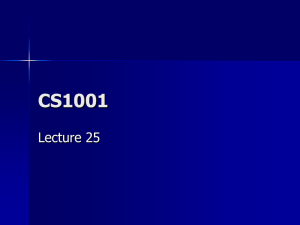
International Journal of Trend in Scientific Research and Development (IJTSRD) International Open Access Journal | www.ijtsrd.com ISSN No: 2456 - 6470 | Volume - 2 | Issue – 6 | Sep – Oct 2018 A Review oon Neural Networks Joselin. J1, Dinesh. T2, Ashiq. M2 1 Assistant Professor, 2Student Department of BCA & MSc SS SS, Sri Krishna ishna arts and Science College, Kuniamuthur, Coimbatore, Tamil Nadu, India ABSTRACT An Artificial Neural Network (ANN) is a structured data processing pattern that is stimulated by the way biological nervous systems, such as the brain, progress information. The key element of this pattern is the new structure of the information processing system. It is a collection of a large number of highly interconnected processing elements (neurones) working in union to solve exact problems. This paper basically focuses on the artificial neural network applications. It also considers the inco incorporation of neural networks with other computing systems Such as vague logic to enhance the construal ability of data. Artificial Neural Networks is considered as major soft-computing computing technology and have been widely studied and applied during the last two epochs. The places where neural networks are most widely used, problem solving that are in pattern recognition, data analysis, control and clustering. Keywords: neurones. neural networks, soft soft-computing, I. INTRODUCTION Artificial intelligence (AI) is defined as intelligence showed by an artificial entity to solve compound problems and such a system is generally assumed to be a computer or machine. Artificial neural networks (ANNs) are widely used in science and technology with applications in various divisions ivisions of chemistry, physics, and biology. A first wave of notice in neural networks also known as connectionist models or parallel distributed processing emerged after the introduction of easy neurons by McCulloch and Pitts in 1943. These neurons were offered ffered as models of biological neurons and as theoretical components for circuits that could perform computational tasks. characterised as “computational models” with specific properties such as the ability ility to familiarize or learn to generalise, or to cluster or organise data, and which operation is based on parallel processing. Artificial ficial Neural Networkis a computational system inspired by the structure, processing Method and learning abilityof a biological gical brain. An ANN is a mathematical representation of the human neural architecture, reflecting its “learning” and “generalization” abilities. For this reason, ANNs belong to the field of artificial intelligence. ANNs are widely applied in research because beca they can model highly non-linear linear systems in which the relationship among the variables is unknown or very compound. Some characteristics of artificial neural networks are: A large number of very simple dispensation neuron-like like processing elements A large ge number of connections between the elements Distributed representation of knowledge over the connections -Knowledge Knowledge is acquired by network through a learning process. Artificial neural networks can be most effectively @ IJTSRD | Available Online @ www.ijtsrd.com | Volume – 2 | Issue – 6 | Sep-Oct Oct 2018 Page: 565 International Journal of Trend in Scientific Research and Development (IJTSRD) ISSN: 2456-6470 2456 Types of Learning in Neural Networks: Supervised Learning:: In supervised learning networks inputs as well as equivalent output is given to the networks. In frontward the errors or inconsistencies between the desired and actual response for each node in the output layer are found. These are then used to control w weight changes in the net according to the main learning rule. The term supervised originates from the fact that the anticipated signals on individual output nodes are provided by an external teacher. Examples of supervised learning are the delta rule, and the perceptron rule [10] Unsupervised Learning: In this type of learning there is no external teacher. So this kind of learning is usually a clustering technique. Patterns clusters are divided into different classes according to inputs. This kind of learn learning is also called as self organisation. Typical examples are the Hebbian learning rule and the competitive learning rule. Unsupervised learning is much more significant then supervised learning since it likely to be much more common in the brain then supervised rvised learning. The kind of learning is determined by the way in which the changes to network parameters have done. Reinforcement learning: This kind of learning is based upon both supervised and unsupervised learning. Reinforcement learning is learning w what to do how to map circumstances to actions so as to maximize a numerical return signal. In this learning there is return for correct outputs and penalty for wrong outputs. Reinforcement learning is also called learning with a detractor as opposed to learning with a teacher the strengths of inputs vectors Xn vectors. Each input is multiplied with weight vectors. The output of the neuron yk is outcome of some activation function on the value of vk. II. ARTIFICIAL NEURAL NETWORKS IN COMPUTER GRAPHICS: Now a days ANN‟ss play an important role in graphics fields also. Graphics designers are trying to amalgamate or merge actual or real images with computer generated images for better visualization of the output image. Most of the realistic images can be generated nerated using Radiosity techniques. Radiosity for computer graphics was first introduced in [Goral et al.1984]. The idea was to feign energy (light) conveyance from diffuse surfaces. The Radiosity method was more developed to account for the interaction of diffuse reflection between objects in scenes. Graphics Pipeline for Radiosity Mathematical model of neural network in figure 3 wk0, wk1……wkp are all are weights to determine It is generally recognized that old-style old implementation of Radiosity is computationally very expensive and therefore not feasible for use in VR (virtual Reality) systems where re practical data sets are of huge complexity. @ IJTSRD | Available Online @ www.ijtsrd.com | Volume – 2 | Issue – 6 | Sep-Oct Oct 2018 Page: 566 International Journal of Trend in Scientific Research and Development (IJTSRD) ISSN: 2456-6470 2456 Modeling and animation of human faces is one of the most problematic tasks in computer graphics today. Facial animations that are created using hierarchical B-spline spline as the fundamental surface representation representation. Neural networks could be used for learning of each disparity in the face expressions for animated sequences. Some clustering and machine learning methods are joint together to learn the correspondence between the speech acoustic and face animation parameters. ters. The key learning machine used for speech facial animations are HMM, SVM and Neural Networks. A. 2D Animation: Two-dimensional dimensional facial animation is commonly founded upon the transformation of images, including both images from motionless photography and sequences of video. Morphing is a technique which allows in-between between provisional images to be generated between a pair of target motionless images or between frames from sequences of video. dimensional head models B. 3D Animation: Three-dimensional provide the most prevailing ling means of generating computer facial animation. One of the earliest works on computerized head models for graphics and animation was done by Parke. The model was a mesh of 3D points controlled by a set of conformation and expression parameters. and give solutionto all kind of viruses. At present, some principal artificial intelligence techniques applied in antivirus detection including heuristic technique, artificial neural network, data mining, agent technique, artificial cial immune and it believes that it will improve the performance of antivirus detection systems. IBM's neural network boot detection technology provides additional security by mimicking human neurons in learning the difference between infected and uninfected ed boot records. By being shown many examples of viruses and non-viruses, non the neural network learned to recognize viruses better than oldold style heuristics hand-tuned tuned by virus researchers. This neural network can detect an extremely high percentage of new and nd unknown boot record viruses automatically. Together, these technologies provide Norton Antivirus customers superior protection against both known and unknown boot sector viruses. Speech Reading (Lip reading): Lip-Reading Reading has been practiced over centuries for teaching deaf and dumb to speak and connect effectively with the other People. Speech Vision, another term for lip-reading reading or speech reading, is a technique of understanding speech Advanced Applications off Neural Networks and Artificial Intelligence: by visually understanding the movements of lips, face and tongue using the information provided (if any) by the context, language, and any remaining hearing. We convert the video of the subject speaking different differ words into images and then images are further selected manually for processing. Some expressions displayed by different virtual humans. Above picture shows different facial expression from different peoples in different situations. Thus neural networks and some others machine learning tools are used for gratitude of expression. Fig.4 Block diagram for lip reading system III. NEURAL NETWORKS STRENGTHENS TECHNOLOGY BEHIND ANTIVIRUS FUNCTIONING: Artificial neural networks and artificial intelligence techniques have played ever more important role in antivirus detection and providing enough strengths to the internal functioning of antivirus so it can detect The input to a lip-reading reading system consists of a video which is first divided into frames. Lips are then segmented on the first frame and then lip curve is determined. An object tracking mechanism is then used to track the motion of lips on subsequent frames. The position of lip contour on each frame is stored in @ IJTSRD | Available Online @ www.ijtsrd.com | Volume – 2 | Issue – 6 | Sep-Oct Oct 2018 Page: 567 International Journal of Trend in Scientific Research and Development (IJTSRD) ISSN: 2456-6470 2456 a database. A distinct database of characters is also maintained. Thee position of lip contour is matched with the characters to determine what the speaker has spoken. APPLICATIONS OF ARTIFICIAL IV. NEURAL NETWORKS: 1. Data mining: Data mining is a part of a procedure called KDD knowledge discovery in files. This process cconsists fundamentally of steps that are performed before resonant out data mining such as data selection, data cleaning, pre-processing processing of data, and data transformation. “Data Data Mining uses computer algorithms to discover hidden patterns and unanticipated relationships lationships among elements in a large data set. AI is a wider area than machine learning. AI systems are knowledge processing systems. Knowledge representation, knowledge acquisition, and inference including search and control, are three important techniques in AI. 2. Knowledge representation: Data mining seeks to determine interesting patterns from large sizes of Data. These patterns take various forms, such as association rules, classification rules, and decision trees, and therefore, knowledge representation becomes a subject of interest in ddata mining. 3. Knowledge acquisition: The discovery process bonds various algorithms and methods with machine learning for the same drive of knowledge acquisition from data learning from examples. 4. Knowledge inference: The patterns discovered from data need to be verified in various applications and so inference of mining results is an essential method in data mining applications. Therefore knowledge representation, knowledge acquisition and knowledge inference, the three ree fundamental techniques in AI are all relevant to data mining. Data mining life cycle 5. Artificial Systems: Expert systems may be measured to be a subset of Artificial Intelligence. Expert system is an artificial intelligence program that has expert-level expert knowledge about a particular domain and knows how to use its knowledge to respond properly. Domain refers to the area within which the task is being completed. Ideally the expert systems should supernumerary a human expert. Expert systems are Artificial Artifi Intelligence programs that have expert level knowledge about a specific domain and know how to use knowledge to responds properly. Domain refers to the area within which a specific task is being performed. Ideally an Expert system should substitute a human expert. Edward Feigenbaum of Stanford University has defined expert system as “an intelligent computer program that uses knowledge and inference procedures to solve problems that are difficult enough to require important human expertise for their solutions. utions. Every expert system consists of two principal parts: A. The knowledge Base B. Reasoning or Inference Engine. Expert system using AI approach Expert system = Knowledge + inference Engine Program in traditional computer =Data = structure+ algorithm 6. Knowledge base: The knowledge base stores all the facts and rules about a particular problem domain. It makes these obtainable to the inference engine in a form that it can use. The facts may be in the form of background data built into the system or facts that are input by the user during a discussion. The rules include both the production rules which applied to the domain of the expert system. The heuristics of rules of-thumb that are provided by the domain expert in order to make the system find solutionss more professionally by taking short cuts @ IJTSRD | Available Online @ www.ijtsrd.com | Volume – 2 | Issue – 6 | Sep-Oct Oct 2018 Page: 568 International Journal of Trend in Scientific Research and Development (IJTSRD) ISSN: 2456-6470 2456 7. Inference Engine: The inference engine is the program that locates the suitable knowledge in the knowledge base, and infers new knowledge by applying logical processing and problem-solving strategies. 8. Natural Language Processing: Natural Language Processing (NLP) is a subfield of Artificial Intelligence. NLP is a method to analysing text that is based on both a set of theories and a set of technologies. NLP is a form of human human-to-computer interaction where the elements lements of human language, be it spoken or written, are formalized so that a computer can perform value adding tasks based on that interaction. Natural Language Processing concerned with the interactions between computers and natural (human) languages like Hindi, English, and Spanish etc. The foundations of NLP lie in a number of disciplines, viz. computer and information sciences, linguistics, mathematics, electrical and electronic engineering, artificial intelligence and robotics, psychology, etc. 9. Goal: The goal of NLP as stated above is “to accomplish human-like like language processing”. The choice of the word „processing‟ is very deliberate, and should not be replaced with Understanding. 10. Robotics: Robotics is one field within artificial intelligence. The term "artificial intelligence" is defined as systems that combine sophisticated hardware and software with elaborate databases and knowledge-based based processing models to demonstrate characteristics of effective human decision making. It involves mechanical, usually computer-controlled, controlled, devices to perform tasks that require extreme precision or tedious or hazardous work by people. Traditional Robotics uses Artificial Intelligence planning techniques to program robot behaviors and works toward robots as technical devices that have to be developed and controlled by a human engineer. The Autonomous Robotics approach suggests that robots could develop and control themselves autonomously. These robots are abl able to adapt to both uncertain and incomplete information in constantly changing environments. It lets a simulated evolution process develop adaptive robots. The most intriguing use of robotics, however, is one that Mitsubishi just recently created. They hav have demonstrated robotic fish running AI programs, and swim around in the water. In fact, they look so real that only a close examination of the fish will reveal their robotic eyes. Two of the many research projects of the MIT Artificial Intelligence department ment include an artificial humanoid called Cog and his baby brother Kismet. What the researchers learn while putting the robots together will be shared to speed up development. Once finished, Cog will have everything except legs, whereas Kismet has only a 36·-kilogram 36· head that can display a wide variety of emotions. Kismet is an autonomous robot designed for social interactions with humans and is part of the larger Cog Project. This project focuses not on robot-robot robot interactions, but rather on the construction ction of robots that engage in meaningful social exchanges with humans The GOALS of most robotic research projects is the advancement of abilities in one or more of the following technological areas Artificial intelligence, effectors and mobility, sensorr detection and especially robotic vision, and control systems. V. CONCLUSION: The computing world has a lot to gain or benefits from neural networks approaches. Their ability to learn by example makes them very flexible and powerful. Furthermore there is no need to devise an algorithm in order to perform a specific task i.e. there is no need to understand the internal mechanisms of that task. REFERENCES: 1. “Advanced Applications of Neural Networks and Artificial Intelligence: A Review” Review by Koushal Kumar Gour Sundar Mitra Thakur. 2. de Rigo, D., Rizzoli, A. E., Soncini-Sessa, Soncini R., Weber, E., Zenesi, P. (2001). "Neuro-dynamic programming for the efficient management of reservoir networks" (PDF).Proceedings of MODSIM 2001 3. Girish Kumar jha, "Artificial Neural Networks and its applications" international journal of computer science and issues 2005. @ IJTSRD | Available Online @ www.ijtsrd.com | Volume – 2 | Issue – 6 | Sep-Oct Oct 2018 Page: 569



